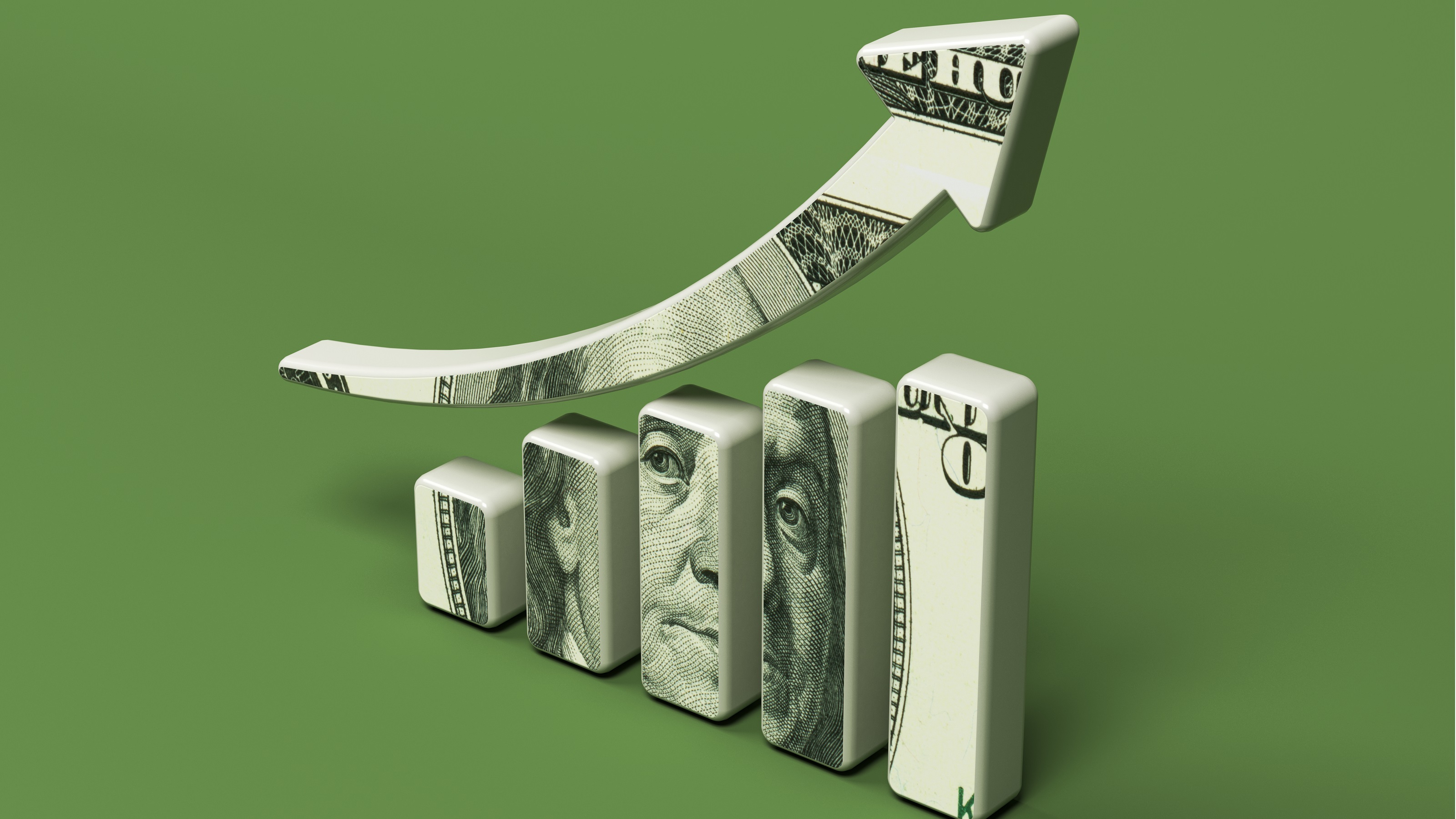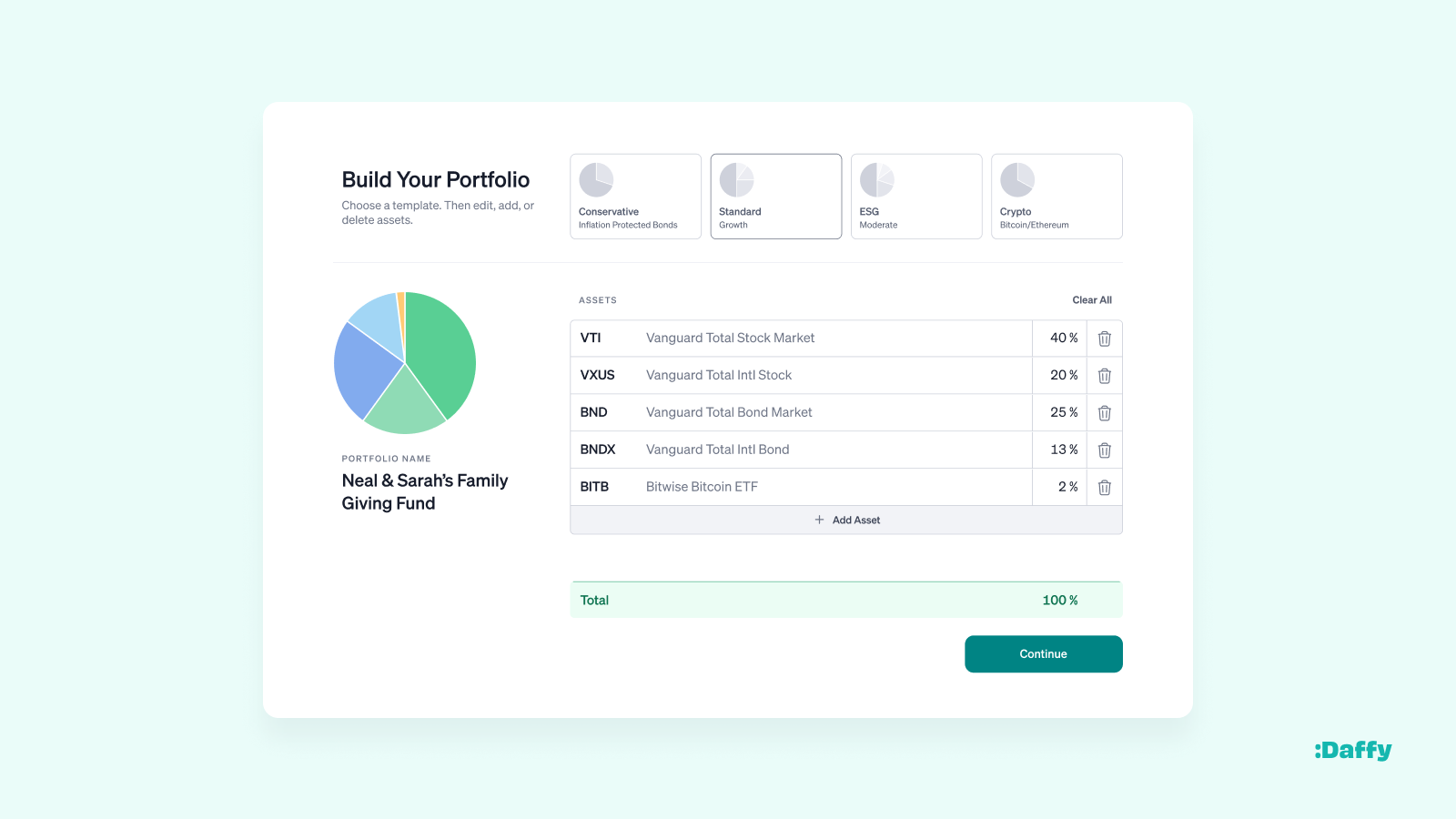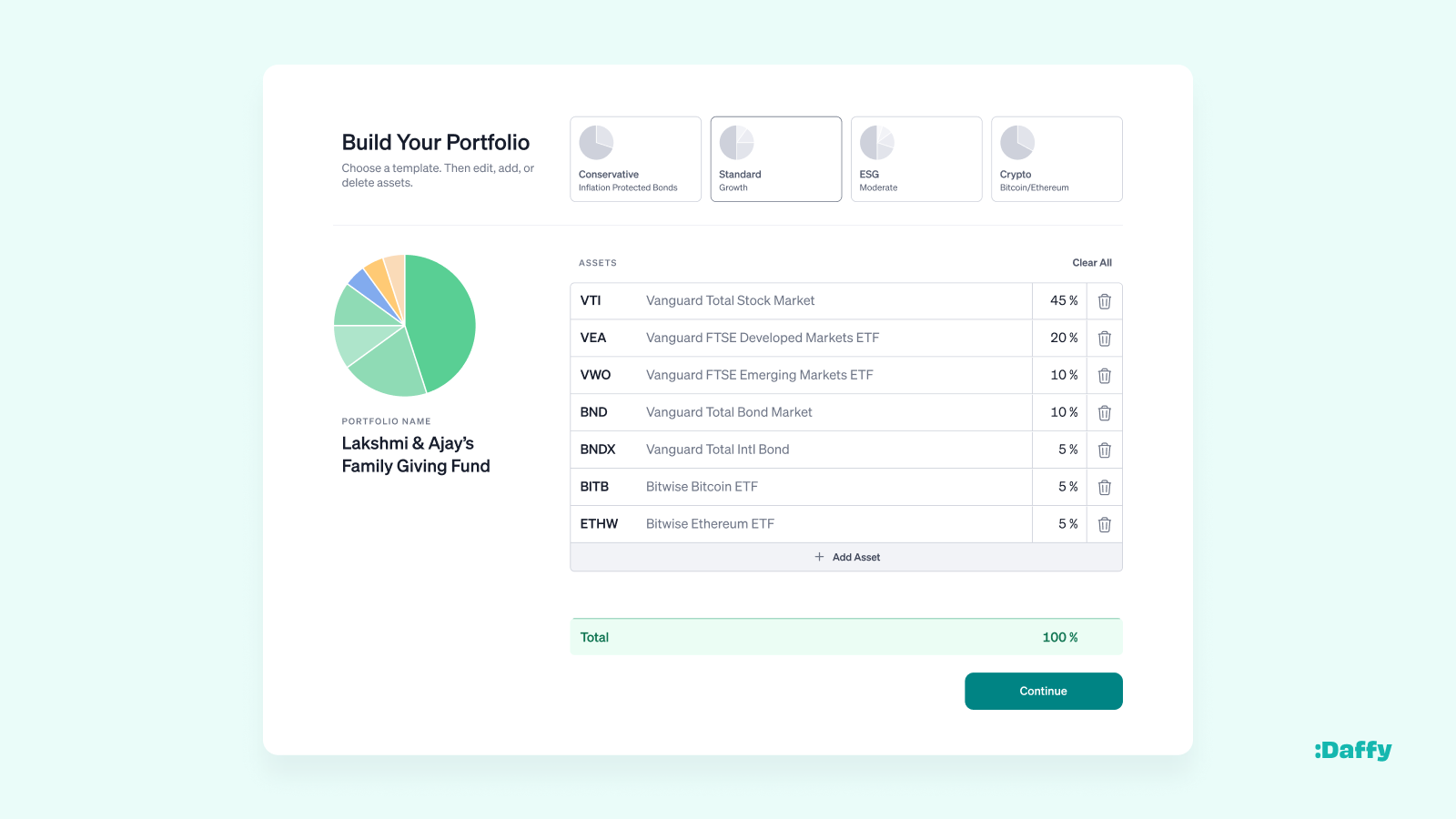
Donor-advised funds (DAFs) are one of the fastest-growing forms of philanthropy in the United States, with over $52 billion granted to charities in 2023.
One of the many benefits of a DAF is the potential for charitable dollars to grow tax-free, which can have a tremendous impact. For example, Daffy members set aside over $105 million for charity last year, and since then, their accounts have grown by over $30 million — an incredible amount raised for charity.
Unfortunately, there is little guidance on developing an investment strategy for a DAF, which is distinctly different from selecting investments for a retirement account. In a retirement account, the primary factors driving investment decisions are typically time horizon and risk tolerance. There’s often a singular goal: building a large enough nest egg to last through retirement.
From just $107.88 $24.99 for Kiplinger Personal Finance
Become a smarter, better informed investor. Subscribe from just $107.88 $24.99, plus get up to 4 Special Issues

Sign up for Kiplinger’s Free Newsletters
Profit and prosper with the best of expert advice on investing, taxes, retirement, personal finance and more - straight to your e-mail.
Profit and prosper with the best of expert advice - straight to your e-mail.
In contrast, the goals for a DAF can vary widely. Some donors contribute regularly, matching their annual giving with weekly or monthly deposits. Others contribute opportunistically, overfunding their accounts in profitable years to support giving in leaner times. Additionally, some donors aim to create a long-term fund that supports annual donations to specific charities for decades, or even indefinitely, like an endowment.
As a result, designing the right portfolio for a DAF requires understanding the giving strategy of the donor.
How to match your investment strategy to your giving goals
Let’s explore a few scenarios to demonstrate different strategies donors might use when investing through their DAF.
A pay-as-you-go plan. Let’s imagine a client named Leah. Leah uses her DAF to donate about $5,000 annually to her child’s school, alongside a few other local and national charities. She contributed $2,000 up front to prepare for an upcoming school fundraiser and established recurring monthly contributions of $300 to support her ongoing giving.
Since Leah plans to distribute most of her contributions this year, she would likely benefit from a conservative portfolio allocated to short-term Treasury bills.
A growth plan. Now consider Neal and Sarah. The couple’s income is fairly stable most years, but Neal’s company went public this year, resulting in a substantial stock-based windfall. They usually donate around $10,000 a year, but they decided to contribute $100,000 this year to their DAF to help manage their increased tax burden from Neal’s stock sales. As a result, most of the funds in their portfolio will be invested for five years or more.
For this couple, a low-cost, globally diversified portfolio of stock and bond funds makes sense. They might even include a small allocation to bitcoin. With a tax-free, automatically rebalanced portfolio in a DAF, their portfolio runs little risk of becoming overweight with high-risk assets.

An endowment plan. Finally, meet Lakshmi and Ajay, who have both had successful careers and wish to create a lasting family legacy through their DAF. They have funded their DAF with over $750,000 in low-cost-basis mutual fund shares that they have held for over 20 years, avoiding any capital gains taxes on those investments. They plan to donate $25,000 annually for the next 20 years, with the intent that their children, Justine and Janan, will eventually succeed in managing the fund.
Given their long-term outlook, an aggressive diversified portfolio with growth-focused investments may be ideal, ensuring that their philanthropic efforts can endure for generations.

The impact of a thoughtful DAF investment strategy
The beauty of a DAF is that it offers the flexibility to adapt your investment strategy to your giving goals, no matter how short term or long term they may be. While not all donor-advised platforms in the U.S. offer clients and advisers the flexibility to customize their portfolio, some, like Daffy, give you the flexibility to select from hundreds of high-quality, low-cost ETFs to fit your giving strategy. (Full disclosure: I am a co-founder and the CEO of Daffy.)
For the 50 million to 60 million U.S. households that give to charity every year, giving is not just a one-off transaction. For many households, it is one of the most important financial goals for their family and their legacy.
So whether you’re looking to fund immediate charitable contributions, leverage market opportunities to maximize future donations or create a legacy that will benefit generations to come, matching your DAF portfolio to your giving strategy is key to making a lasting impact.
The information provided is for educational purposes only and should not be considered investment advice or recommendations, does not constitute a solicitation to buy or sell securities, and should not be considered specific legal investment or tax advice. To assess your specific situation, please consult with a tax and/or investment professional.
Related Content
- Donor-Advised Funds: A Tax-Savvy Way to Rebalance Your Portfolio
- If You Give to Charity, ‘Bunching’ Could Save You Thousands
- Which Type of Donor-Advised Fund Is Right for You?
- Should a Donor-Advised Fund Be Part of Your Estate Plan?
- A Donor-Advised Fund Can Give Your Charitable Giving a Boost
Profit and prosper with the best of Kiplinger's advice on investing, taxes, retirement, personal finance and much more. Delivered daily. Enter your email in the box and click Sign Me Up.

Adam Nash is the co-founder & CEO of Daffy.org, the Donor-Advised Fund for You™, an innovative, fast-growing platform for charitable giving. With no minimum to get started, industry-low fees and ground-breaking technology, Daffy brings the donor-advised fund back to its original goal of helping people be more generous, more often. Adam has served as an executive, angel investor and adviser to some of the most successful technology companies to come out of Silicon Valley. He is currently on the Board of Directors for Acorns, the country’s fastest-growing financial wellness system, and Shift Technologies.
-
 Gold and Silver Shine as Stocks Chop: Stock Market Today
Gold and Silver Shine as Stocks Chop: Stock Market TodayStocks struggled in Friday's low-volume session, but the losses weren't enough to put the Santa Claus Rally at risk.
-
 Don't Wait Until January: Your Year-End Health Checklist to Kickstart 2026
Don't Wait Until January: Your Year-End Health Checklist to Kickstart 2026Skip the fleeting resolutions and start the new year with a proactive plan to optimize your longevity, cognitive health, and social vitality.
-
 Premium Rewards Cards: More Perks, Higher Fees
Premium Rewards Cards: More Perks, Higher FeesSome issuers are hiking the annual fee on their flagship luxury credit cards by hundreds of dollars. Are they still worth using?
-
 Gold and Silver Shine as Stocks Chop: Stock Market Today
Gold and Silver Shine as Stocks Chop: Stock Market TodayStocks struggled in Friday's low-volume session, but the losses weren't enough to put the Santa Claus Rally at risk.
-
 Your Year-End Wellness Checklist for a Healthier 2026
Your Year-End Wellness Checklist for a Healthier 2026Skip the fleeting resolutions and start the new year with a proactive plan to optimize your longevity, cognitive health, and social vitality.
-
 Premium Rewards Cards: More Perks, Higher Fees
Premium Rewards Cards: More Perks, Higher FeesSome issuers are hiking the annual fee on their flagship luxury credit cards by hundreds of dollars. Are they still worth using?
-
 3 Trips to Escape the Winter Doldrums, Including An Epic Cruise
3 Trips to Escape the Winter Doldrums, Including An Epic CruiseThree winter vacation ideas to suit different types of travelers.
-
 How to Master the Retirement Income Trinity: Cash Flow, Longevity Risk and Tax Efficiency
How to Master the Retirement Income Trinity: Cash Flow, Longevity Risk and Tax EfficiencyRetirement income planning is essential for your peace of mind — it can help you maintain your lifestyle and ease your worries that you'll run out of money.
-
 4 Financially Savvy Things to Do with Unwanted Gifts
4 Financially Savvy Things to Do with Unwanted GiftsDon't send that unwanted gift to the landfill. Find a way to squeeze out some of its cash value instead.
-
 I'm an Insurance Expert: Sure, There's Always Tomorrow to Report Your Claim, But Procrastination Could Cost You
I'm an Insurance Expert: Sure, There's Always Tomorrow to Report Your Claim, But Procrastination Could Cost YouThe longer you wait to file an insurance claim, the bigger the problem could get — and the more leverage you're giving your insurer to deny it.
-
 Could a Cash Balance Plan Be Your Key to a Wealthy Retirement?
Could a Cash Balance Plan Be Your Key to a Wealthy Retirement?Cash balance plans have plenty of benefits for small-business owners. For starters, they can supercharge retirement savings and slash taxes. Should you opt in?
